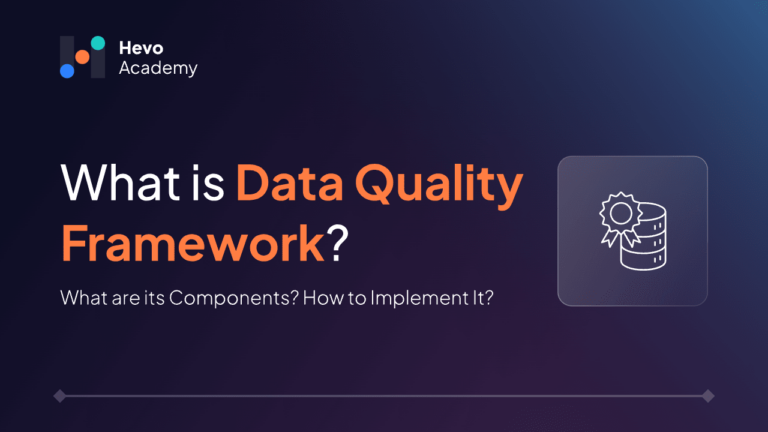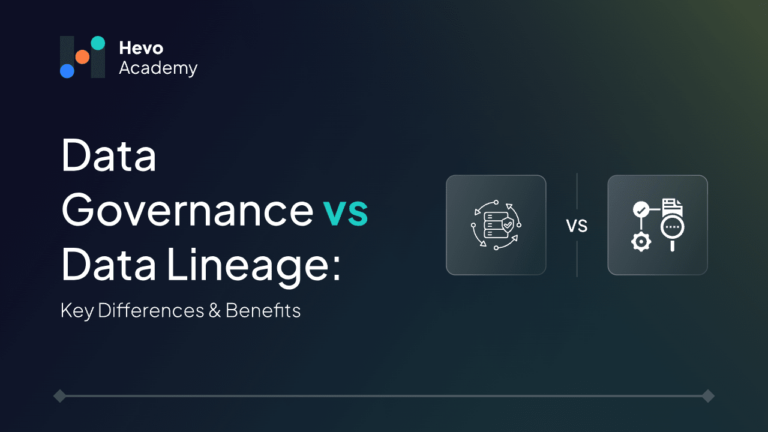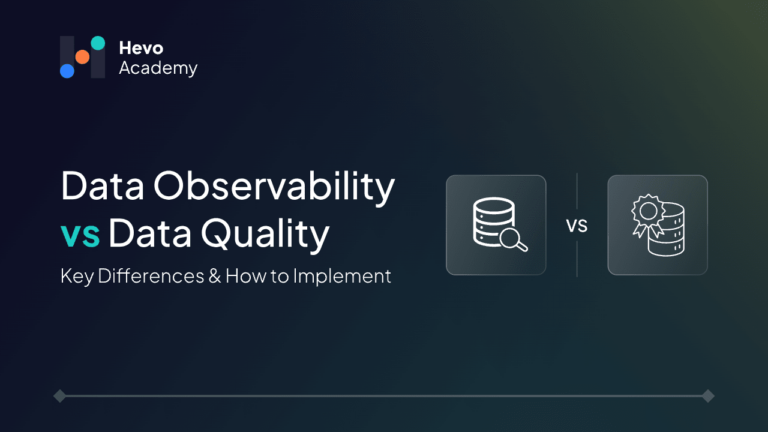Improving data visibility isn’t just about integrating tools; it requires a strategic approach to maximize potential. With more than 70%1 of businesses facing data quality issues, the significance of robust data observability practices is evident. This extends beyond just keeping an eye on things; it includes understanding the condition, source, and trustworthiness of your data. Recognizing the significance of enhanced data observability is crucial for staying competitive, as data impacts strategic decision-making.
Table of Contents
This article delves into the importance of data observability, assisting in improving visibility and control. Going further than just observing, you will discover the issues and how to resolve them.
What is a Data Observability?
While building data pipelines, your team might encounter challenges like data accuracy issues, pipeline breakdowns, slow performance, and insufficient transparency. While various methods can be helpful, data observability shines as the most efficient choice because it offers live tracking and a deep understanding of your data environment.
What is the definition of data observability? Your ability to manage and understand the state of your data network, including its dependability, punctuality, magnitude, structure, and origin. Data observability differs from conventional monitoring in that it offers a comprehensive perspective and allows for quick detection and resolution of anomalies.
For instance, if your e-commerce platform tracks customer orders, then when order volumes drop, that is where data observability tools help pinpoint whether it’s a technical glitch, pipeline issue, or data input anomaly for prompt resolution.
What are the Pillars of Data Observability?
Sustaining operational health and trustworthiness of data calls for data observability to observe the five pillars of the framework. Every pillar is significant in preserving data integrity and generating useful insights. We will take an examination of each one:
- Data Freshness makes sure your information is current, avoiding the pitfalls of relying on outdated data for critical decisions. Using recent data helps prevent inaccurate conclusions and ineffective strategies. For example, outdated customer data can lead to poor marketing outcomes.
- Data Distribution examines the expected ranges and patterns of data points, detecting any anomalies that could indicate issues. For example, ensuring sales data follows seasonal trends helps maintain data reliability.
- Data Volume gives a measurable quantity of the data that is being managed and assures to ensure it falls within the expected ranges, preventing issues like duplication. Monitoring daily uploads helps identify notable changes. For instance, an unexpected spike in data volume may indicate duplication issues.
- Data Schema is concerned about data being organized and formatted correctly to avoid pipeline disruptions. Validating that new data matches the expected structure is critical. For example, schema validation ensures new data entries conform to required formats, preventing errors.
- Data Lineage traces the source and changes of data during its entire existence. Recognizing the source and history of your data is key to spotting errors and promoting responsible data management. For instance, Monitoring the origin and evolution of data from its source to the final report.
What is the Importance of Data Observability in Modern Data Management?
You already understand that data observability is more than just a trend—it’s essential in today’s data-driven landscape. Picture this: your organization is gearing up to launch a new product, and the stakes are high.
Ensuring that the data driving your decisions is accurate and reliable becomes critical. Here’s why you should prioritize data observability:
- Proactive Issue Resolution to identify and address anomalies in real-time, preventing disruptions.
- Enhanced Data Quality to maintain high accuracy and integrity in data, ensuring trustworthy decisions.
- Improved Collaboration for a centralized platform boosts communication and quick resolutions among teams.
- Informed Decision-Making is having real-time data visibility for timely and agile decisions.
- Regulatory Compliance via simplified data lineage tracking ensures adherence to regulations and eases audits.
In essence, adopting data observability practices transforms how your organization leverages data for strategic advantage.
The Hierarchy of Data Observability
A layered approach ensures thorough monitoring and validation of data quality and reliability at various levels by understanding the hierarchy of the data observability framework for its clarity and efficiency in managing data systems.
We explore the hierarchy for data accuracy, reliability, and integrity:
- Operational Health and Dataset Monitoring: This is the foundational level where you track essential metadata. For example, ensure that data arrives on time and in the correct format to prevent downstream errors.
- Column-Level Profiling: Here, you audit individual data categories to create rules and pinpoint inconsistencies. For example, examining column statistics can uncover unforeseen alterations in data distributions, bringing attention to possible problems.
- Row-Level Validation: At this stage, each piece of data is examined against predefined rules to verify correctness. Validating that customer IDs are unique is one way to prevent duplication errors that could skew analyses.
- Data Lineage Tracking: This involves tracing the source and changes of data throughout its lifecycle. Mapping the journey of sales data from entry to reporting provides insights into its transformation and impact.
- Anomaly Detection and Alerts: Finally, you implement automated systems for identifying anomalies in real time and sending out alerts. If there is a sudden increase in transaction volumes, an alert can be triggered for quick investigation in order to avoid fraud or operational problems.
Implementing a Data Observability Framework
Building a solid foundation in data management involves understanding how to implement data observability. Once your company masters this, effectively managing data quality and fostering team accountability becomes a smooth journey. Here’s a ten-step approach to enhance data quality and foster accountability:
- Specify goals focused on data quality and reliability. Involve stakeholders for comprehensive input.
- Evaluate your existing data infrastructure, including systems, procedures, and tools, in order to pinpoint both strengths and weaknesses.
- Establish protocols for data collection to obtain information from multiple sources for thorough monitoring.
- Set up monitoring and alert systems to constantly watch for anomalies in continuous monitoring systems.
- Visualization and Analysis for ongoing monitoring of data metrics in real time.
- Make sure security measures are implemented and regulatory compliance is ensured.
- Encourage teamwork and communication among data management teams by promoting collaboration across different teams.
- Provide training and orientation for employees to ensure effective utilization of observability tools.
- Consistently monitor key performance indicators to assess the efficiency of the observability framework.
- Sustainably improve methods through feedback and changing requirements.
Mastering Data Observability: Key Comparisons with Monitoring, Quality, Reliability, and Governance
| Criteria | Data Observability | Data Monitoring | Data Quality | Data Reliability | Data Governance |
| Definition | Understanding the health and status of data systems holistically | Tracking specific metrics and events within data systems | Ensuring data is accurate, complete, consistent | Ensuring data remains consistently available and correct | Policies and procedures for managing data |
| Scope | Comprehensive, includes data flow and system health | Narrow, specific metrics and events | Focus on data attributes | Focus on data integrity and availability | Focus on data management and compliance |
| Objective | Proactive issue detection and resolution | Monitoring system performance and triggering alerts | Ensuring high-quality data for decision-making | Maintaining data integrity over time | Ensuring data compliance and proper management |
| Tools Used | Advanced tools for full-stack visibility | Simple dashboards, monitoring tools | Data validation and cleaning tools | Data consistency and integrity checks | Data policies, frameworks, tools for governance |
| Outcome | Enhanced understanding of data ecosystems, faster issue resolution | Immediate alerts on performance issues | High-quality, accurate data | Consistent and reliable data | Compliance with regulations, effective data management |
| Proactive vs Reactive | Proactive, anticipates and solves issues | Mostly reactive, deals with issues as they arise | Proactive, ensures data meets standards | Proactive, maintains data integrity | Proactive, enforces rules and policies |
The Benefits of Implementing a Data Observability Platform
Your company should receive more than just standard data tracking. If you lack a strong data observability platform, you face inefficiencies, mistakes, and overlooked changes. A modern data management system is essential as data quantities increase, particularly for products that interact with customers. This is when a complete data observability platform is needed.
Still not convinced? Here are several compelling benefits of implementing a data observability platform:
- Faster resolution of data incidents is achieved by quickly identifying and solving issues in data pipelines, leading to decreased periods of downtime.
- A centralized system enhances communication and collaboration between data engineers, analysts, and stakeholders, guaranteeing consensus on data quality.
- The ability to detect anomalies and data quality checks early is enabled by advanced analytics and monitoring capabilities.
- Ensured accuracy and reliability for crucial decision-making is achieved by implementing thorough observability measures that increase confidence in data.
- Having a clear understanding of the entire data processing helps in closely monitoring changes and history of data, which is essential for compliance and audit tasks.
Choosing the Right Data Observability Platform
Selecting the ideal data observability platform requires careful consideration of several critical factors to ensure it meets your organization’s specific needs. A strong foundation goes beyond basic observation, we help you select a data observability platform that meets your current needs and scales with your business.
| Factors to Consider | Key Features to Look For | How to Ensure |
| Scalability | Real-Time Monitoring | Ensure the platform can grow with your data needs without compromising performance. Look for continuous tracking capabilities. |
| Integration Capabilities | End-to-End Data Lineage | The ability to seamlessly integrate with existing tools and systems is crucial. Ensure visibility into the entire data journey. |
| User-Friendly Interface | Automated Alerts and Notifications | A platform that is easy to navigate will enhance team adoption and efficiency. Set up alerts to quickly respond to anomalies. |
| Cost-Effectiveness | Advanced Analytics and Reporting | Evaluate the total cost of ownership, including maintenance and operational costs. Ensure it fits your budget and provides robust analytics. |
| Support and Community | Customizable Dashboards | Strong customer support and an active user community enhance the experience. Allow customization to visualize key metrics effectively. |
Best Practices for Implementing Data Observability
If your data teams lack knowledge on how to implement data observability, you will once again encounter challenges such as data quality issues, pipeline breakdowns, and performance bottlenecks. Below are the key 7 recommendations to guarantee efficient data observability.
- Automated Monitoring tools continuously track data pipelines, infrastructure, and applications for issues. This guarantees immediate identification of irregularities, maintaining data integrity, and avoiding interruptions.
- Top Tip: Regularly update your monitoring tools to keep up with evolving data environments.
- Real-Time Alerts notify you of potential data problems as they occur, allowing for quick reactions to minimize downtime and data loss.
- Top Tip: Personalize notification preferences to reduce false alerts.
- Root Cause Analysis identifies the underlying causes of data issues to prevent future occurrences. Root cause analysis improves problem-solving efficiency and reduces recurring issues.
- Top Tip: Maintain a knowledge base of issues and resolutions for future reference.
- Data Lineage Tracking tracks the flow and transformation of data throughout its lifecycle. This improves traceability and accountability, aiding in troubleshooting and compliance.
- Top Tip: Integrate data lineage tracking with your data governance practices.
- Anomaly Detection uses algorithms and models to identify unusual data patterns, detecting hidden issues that standard monitoring might miss.
- Top Tip: Regularly evaluate and refine anomaly detection models for accuracy.
- Performance Metrics Key performance indicators (KPIs) measure the efficiency and effectiveness of data systems, providing insights into system performance and areas for improvement.
- Top Tip: Review and adjust KPIs periodically to align with changing business goals.
- Regular Audits Conduct periodic reviews and audits of data processes, quality, and compliance to ensure data integrity and continuous improvement.
- Top Tip: Combine automated and manual audits for comprehensive coverage.
References
Conclusion
Your organization’s data is a vital asset; merely monitoring it is insufficient to ensure its integrity. In today’s intricate data landscape, comprehensive data observability is crucial. It empowers you to foresee potential issues, trace data origins, and guarantee data accuracy. This technique enhances data control and facilitates improved decision-making. We strongly recommend that you utilize data observability methods to:
- Recognize and resolve issues with data at an earlier stage.
- Maintain accurate, reliable data for making trustworthy decisions.
- Track where data comes from to meet regulatory standards.
At Hevo Data, we focus on making it easier to incorporate seamless data integration into your operations, which can be a complicated process. That’s where the Hevo Data professionals come in. We strategize, plan, and manage the complete data integration workflows so you can focus on analyzing data and making strategic decisions.
Connect with us now today to transform your data integration experience.
FAQs
1. What is the difference between data quality and data observability?
Data quality ensures data is accurate, complete, and reliable. Data observability, however, enables monitoring, understanding, and improving data health. It goes beyond the state and offers insights into data flow, helping to proactively detect and resolve issues. Together, they ensure trustworthy data for critical decisions.
2. What are the four pillars of observability?
Metrics, logs, traces, and profiles form the core framework for understanding system health.
-Metrics quantify performance like response times and error rates.
-Logs capture detailed records of events within systems.
-Traces map the flow of requests to identify bottlenecks.
-Profiles analyze code execution behavior to pinpoint performance problems.
3. What are the three types of observability?
The three types are logs, metrics, and traces. Logs provide event context, metrics quantify performance such as latency or throughput, and traces show request paths through system components, highlighting delays or failures. Together, they offer deep system insights for effective issue resolution.
4. What are the 4 signals of observability?
Freshness, distribution, volume, and lineage maintain data quality and operational efficiency.
Freshness ensures timely data updates, distribution checks data patterns, volume monitors data quantity, and lineage tracks data origin.





